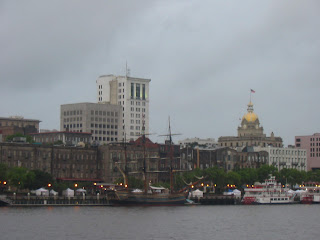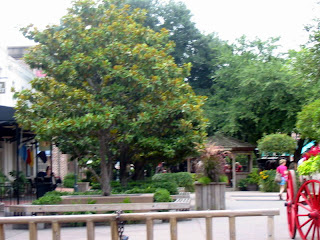
On the bluff facing the Savannah River are nine blocks of renovated cotton warehouses that house about 80 restaurants, pubs, night spots, hotels, shops, galleries, and boutiques. Adding to the sight-seeing is a working harbor of huge, building-size ships and working tugs. Often, sailing ships from various countries are seen plowing the murky waters of the Savannah River. During the day, families stroll alongside the river, eating ice cream cones and browsing in gift shops. At night, people are eating at one of the many restaurants located on the river. Later in the night, Savannah's night life begins as the clubs and bars turn-up the music and invite you in to have fun and enjoy the beverage of your choice.
On River Street, there are several good options for lodging that offer a view of Savannah's main natural attraction (the river), along with quick walking access to River Street, City Market, and the historic squares of the city.
It hasn't always been this way. The city had turned its back on the historic waterfront, which was abandoned and deteriorating when a wide-ranging group of civic leaders joined forces in the early 1970s to create the River Street Urban Renewal Project. When the work was finished in 1977, approximately 80,000 square feet of abandoned warehouse space on the historic waterfront had been transformed into Savannah's most popular tourist attraction. Additional improvements have produced an attractive city park that hosts many festivals and special events.
The ambiance of the waterfront is an atmospheric fusion of nineteenth century old-world charm and twentieth century tourist potpourri. Stony ramps that connect Bay Street with River Street are made of English ballast stones, which gave schooners added stability for their trips from Europe, only to be thrown out and replaced with cotton bales in Georgia. The stones were used in buildings and walkways, and became the foundation of ballast stone islands found today in river channels.
Along the waterfront are three memorials worth closer examination. The first is the Freedom Monument designed to mark the disembarkation site of kidnapped Africans. A second monument is the Waving Girl, a 1971 statue by Felix De Weldon that honors Florence Martus, a Savannahian who greeted every ship entering the port from 1887 to 1931 by waving a cloth from her home on Elba Island . Further to the east is a memorial to the 1996 Olympics, during which Savannah hosted the yachting event.
On the bluff next to Bay Street are the gold-domed City Hall, Factors Walk, and Emmet Park . City Hall was built in 1905 on the site of the Old City Exchange. Earlier this year, the dome on top of the City Hall was re-gilded. Notice the bench commemorating Oglethorpe's landing on February 12, 1733. Factors Walk once housed the offices of nineteenth century cotton merchants. Today, a variety of businesses call it home. Of interest to the historian are the Washington Guns, presented by George Washington when he visited Savannah in 1791. The bronze cannons were captured from the British at Yorktown.
















